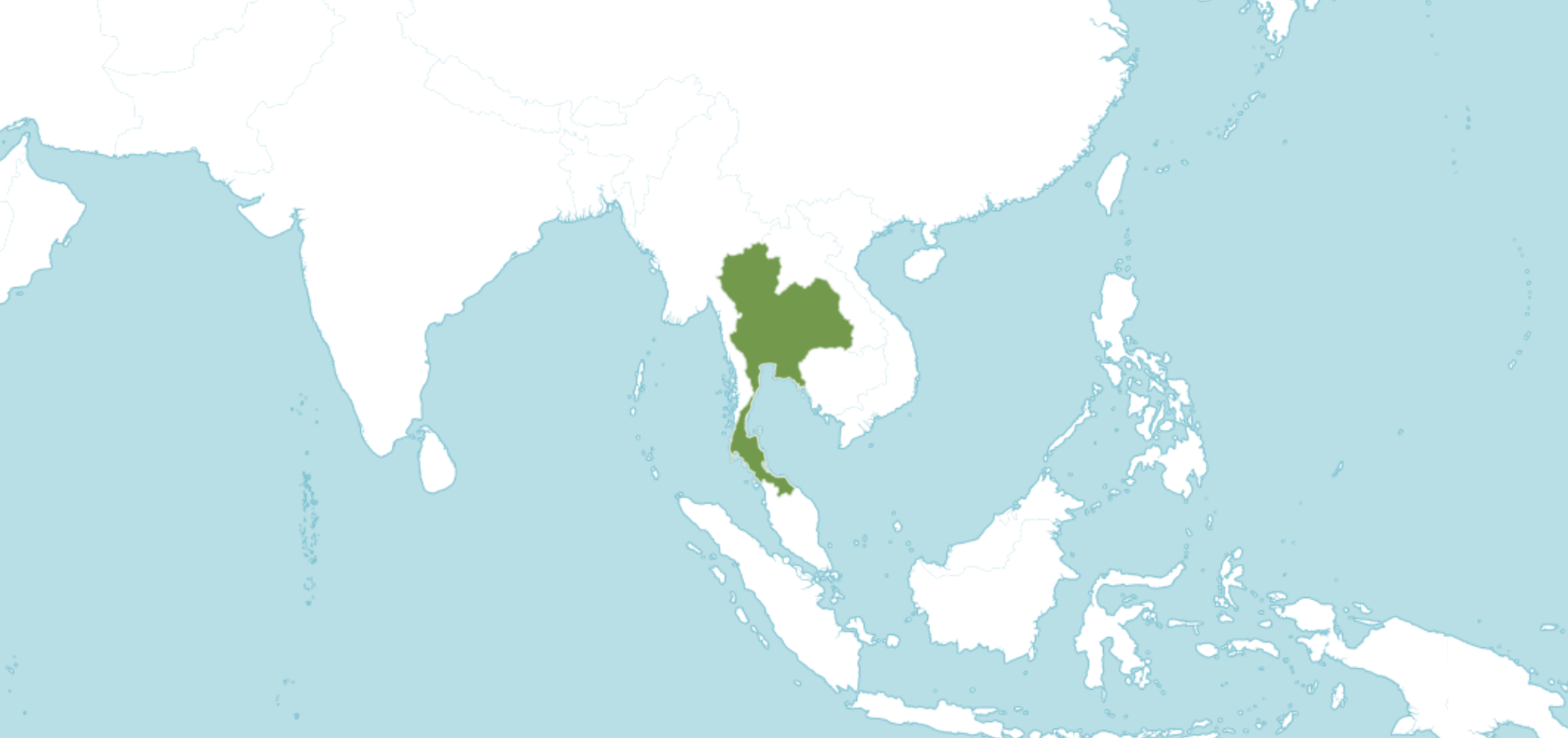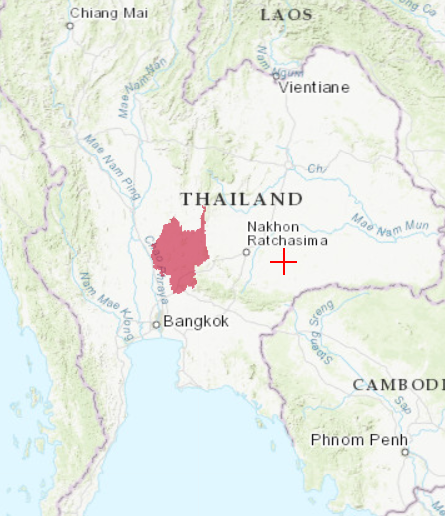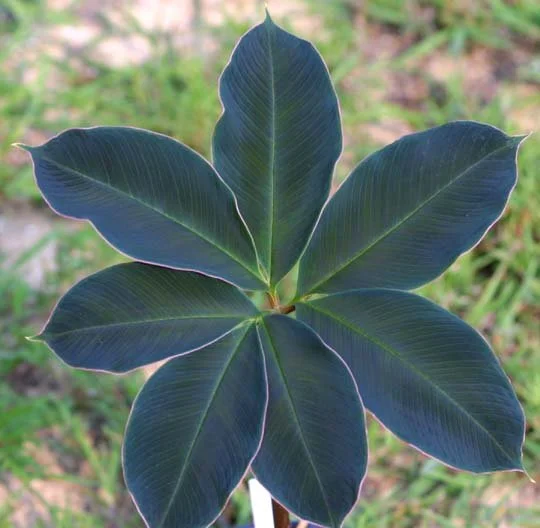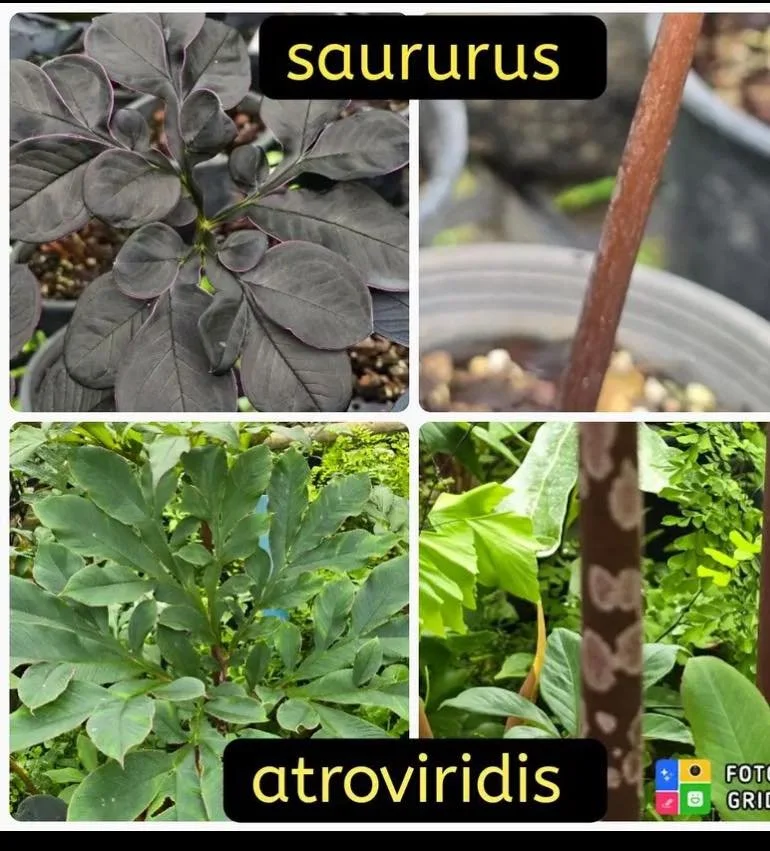AMORPHOPHALLUS ATROVIRIDIS
ORIGINAL DESCRIPTION:
Amorphophallus atroviridis Hett., spec. nov
A speciebus omnibus in tubere elongato, staminodiorum complanatorum zona inter zonis masculas femineasque differt
Typus: Hetterscheid H.AM. 107-T (L holo; spirit coll.), 22-iii-1991, cult. Hort. Bot. Leiden ex Thailand (no locality; type plant obtained from S. Hyndman).
SYNONYMS:
HOMOTYPIC SYNONYMS: N/A
HETEROTYPIC SYNONYMS: N/A
ACCEPTED INFRASPECIFICS: N/A
DISTRIBUTION: Thailand | CENTRAL: Saraburi, Lop Buri.
CLIMATE: Unknown
ECOLOGY: In heavy shade at the base of a limestone outcrop.
SPECIES DESCRIPTION:
Tuber napiform, up to 11 cm long. Leaf solitary; petiole 10-45 cm long, up to c. 1.5 cm in diam. (base), dark reddish brown with some rounded, dirty white, brown centred spots and numerous tiny, dirty white dots, densely velvety hairy; lamina with few leaflets (5 or 6), 18-55 cm in diam., rhachises winged; leaflets large, obovate, shortly acuminate, slightly succulent, 9-25 cm long, 4.5-12 cm in diam., upper surface with minute, erect, white hairs, dark emerald-green with a conspicuous, pinkish violet margin and often a bluish sheen, margin undulate, lower surface greyish green, with numerous tiny white hairs, main and secondary veins pale pink, the surface in between less hairy, margin pinkish violet.
INFLORESCENCE:
Inflorescence solitary; peduncle like petiole, c. 30 cm long, c. 1 cm in diam. (base); spathe erect, c. 10 cm long, lower third convolute, separated from the limb by a shallow constriction, limb triangular, acute, margins slightly reflexed, base outside dirty whitish, upwards grading into pale brown with many scattered, small, irregular, dirty white spots, the margin pinkish violet, main veins in the lower half dark brown, inside pale whitish green, suffused with purplish near the upper margin, entire margin pinkish violet, surface densely clothed with irregularly shaped, more or less flattened warts. Spadix sessile, about twice as long as spathe, up to 25 cm; female part cylindric, c. 1 cm long, c. 1.2 cm in diam., flowers slightly distant; male part elongate-conic, c. 7 cm long, c. 1.5 cm in diam. (near base), flowers congested; sterile zone between male and female parts short, carrying a few staminodes; appendix elongate conic, slender, acute, irregularly, shallowly sulcate with some small, punctiform warts, brown, c. 18 cm long, c. 1.3 cm in diam. (near the base), developing a strong, cheesy smell at female anthesis. Ovaries depressed, c. 2.5 mm in diam., c. 1.5 mm high, pale green, near the style-insertion dirty violet, unilocular; style c. 1 mm long, 0.8 mm in diam., straight or slightly upcurved, dirty violet; stigma depressed, irregularly disciform, rounded or slightly angulate in cross section, c. 2 mm in diam., c. 0.6 mm high, surface with several very small knob-like warts and one usually eccentric large conicrounded wart/lobe, dirty orange-yellow. Maleflowers consisting of 3-5 stamens, creamy white; filaments short, fleshy, c. 1.5 mm long, c. 2 mm in diameter, in the lowermost flowers entirely connate and strongly enlarged and then c. 5 mm long; anthers c. 1 mm long, c. 2 mm in diameter (in some of the basalmost flowers strongly reduced and often sterile), the top rounded, pores apical, elongate; staminodes semiflattened, oval in cross section, c. 5 mm in diameter, ivory-white. Pollen striate.
VARIEGATED FORMS: N/A
ETYMOLOGY: The species epithet refers to the greenish-reddish colour of the upper surface of the leaflets
NOTES:
Amorphophallus atroviridis is in many respects morphologically similar to Amorphophallus brevispathus and Amorphophallus macrorhizus Craib, both from Thailand. The velvety hairiness and the elongate tubers are found in both species and the dark emerald green, pinkish violet margined leaves are also found in Amorphophallus macrorhizus. Compared with Amorphophallus macrorhizus, Amorphophallus atroviridis is much smaller, has a prominent style, no hairs on the appendix; compared to Amorphophallus brevispathus the species has larger male flowers, a longer style, a flattened stigma and larger leaves.
The present species has been obtained from cultivated stock through Mr. Scott Hyndman ofFlorida (USA). It has long been in cultivation in the USA as Thomsonia larsenii Hu (a synonym of Amorphophallus brevispathus).
Additional specimen - Smitinand & Phengkhlai 8835 (BKF), Thailand, Khao Phaeng, among limestone boulders, 3-vii-1965.
Amorphophallus saurus is often sold incorrectly under the name Amorphophallus atroviridis as foliage and inflorescences can look quite similar, with the main difference being that Amorphophallus saurus has a smooth petiole while Amorphophallus atroviridis has a speckled petiole
CULTIVARS: N/A
HYBRIDS: N/A
REFERENCES:
Photos by Aroidpictures.fr and Justin Jones
























